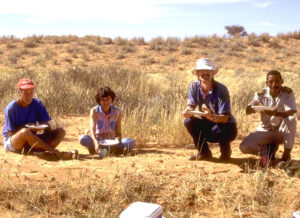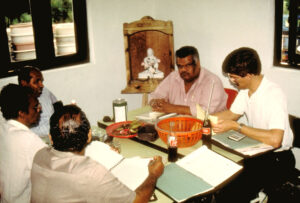Germplasm Exploration, Evaluation
International Activities in Cucurbit Breeding
Germplasm Collection
Training of international scientists, cooperative research with scientists around the world, and germplasm collection are the major international activities of the cucurbit breeding project at NC State University. Work typical of this project is outlined below, as well as on another page, International Training of Horticultural Breeders (FAO-NCSU), and reports by former FAO scientists such as Kanwaldeep Singh.
New scientists on the cucurbit breeding project at NC State should visit the page on getting established.
One of the objectives of my project is to collect germplasm from the centers of origin (Vavilov) or centers of diversity (Harlan) for cucumber, melon, gourd, and watermelon. Below are some of the expeditions I have been involved with.
 South Africa
South Africa
A team of 4 researchers — Todd Wehner (NCSU, Raleigh, NC), James McCreight (USDA-ARS, Salinas, CA), Roger Ellis and Mariana Jooste (PGRU-ARC, Pretoria, RSA) — collected cucurbit germplasm from the arid regions of the Republic of South Africa near Zimbabwe, Botswana, and Namibia. The trip was 4,213 km (2528 miles) in length. The first photograph shows seed collection from wild relatives of melon near the border with Zimbabwe.
Objective
The objective of the expedition was to collect land races and related species of melon and watermelon (Cucumis melo and Citrullus lanatus) from areas that were remote and less developed. The primary centers of diversity for watermelon are eastern and southern Africa, so the collections are expected to be valuable to plant breeders and others interested in preserving accessions of potential use to agriculture (Whitaker and Davis, 1962). The second photograph shows 3 of the 4 team members having lunch with the ranger (protective escort) in the Kalahari Desert near the border with Namibia.
Accomplishments
One major accomplishment was to establish links between U.S. researchers interested in cucurbit germplasm and the new Plant Genetic Resources Unit in Pretoria, Republic of South Africa. A second accomplishment was to collect melon (Cucumis) and watermelon (Citrullus) land races, and related species (Kirkbride, 1993). Such germplasm is useful for improving cultivars by adding new traits or increasing performance. Future germplasm exchanges with and expeditions to southern Africa are needed to expand the world’s germplasm collection of species related to melon and watermelon. The primary countries of interest for new expeditions are Namibia, Botswana, Zimbabwe, Zambia, and Angola.
 China
China
A team of 4 researchers (Todd Wehner, James McCreight, Bill Rhodes and Xingping Zhang) went to the People’s Republic of China to exchange cucurbit germplasm and tour institutes working in areas of mutual interest. The third photograph shows the team in a Mongolian-style restaurant in Beijing.
Objectives
The objectives of Team #8 were to exchange germplasm of cucumber, melon watermelon and gourd between the People’s Republic of China and the U.S., to find common areas of research on cucurbit breeding, and to learn about research being done at the major cucurbit institutes in the People’s Republic of China. Gourds are not a major emphasis in either country, but information was gathered where possible.
The itinerary of the trip took the team through the northern provinces of the People’s Republic of China, with stops in Shanghai, Zhengzhou, Xian, Yangling, Urumqi, Turpan, ChiangJi City, Beijing and Tianjin.
 Accomplishments
Accomplishments
Germplasm collected from PRC consisted of 51 watermelons, 50 cucumbers, 30 melons, 15 luffa gourds and 2 bittergourds. Germplasm given to PRC included 13 cucumbers, 1 luffa gourd, 26 melons and 11 watermelons. The fourth photograph shows the team at a research station near Shanghai.
Accomplishments included the germplasm exchange mentioned above, but more importantly, cucurbit researchers from the two countries got acquainted with each other. Future opportunities for cooperative research may be the most useful accomplishment for the two countries.
Cucurbit scientists from PRC were invited to visit researchers in the U.S. doing work in those areas.
 Sri Lanka
Sri Lanka
A team of 2 — Todd Wehner (NCSU researcher), and Jonathan Schultheis (NCSU extensionist) — consulted with cucumber growers and processors in Sri Lanka. Their tour covered the production areas of the Sri Lanka Gherkin Exporters and Growers. The 5 processing companies involved were SunFrost, Forbes, Aitken-Spence, Pickle Packers, and Vanathawilluwa. The tour went through Colombo, Puttalam, Anuradhapura, Sigiriya, irrigation system C, Mahiyangana, Kandy, Embilipitiya, and back to Colombo. The fifth photograph shows the team consulting with processors at Vanathawilluwa.
Objective
The objective of the consulting tour was to assist the Sri Lanka Gherkin Exporters and Growers in producing small pickling cucumbers for export to other countries.
 Accomplishments
Accomplishments
Solutions were provided for disease and insect control, improved yield, and better adapted cultivars. The sixth photograph shows cucumbers being grown in a rice paddy.
Additional work was recommended for the growers to run performance trials on new cultivars and production practices.